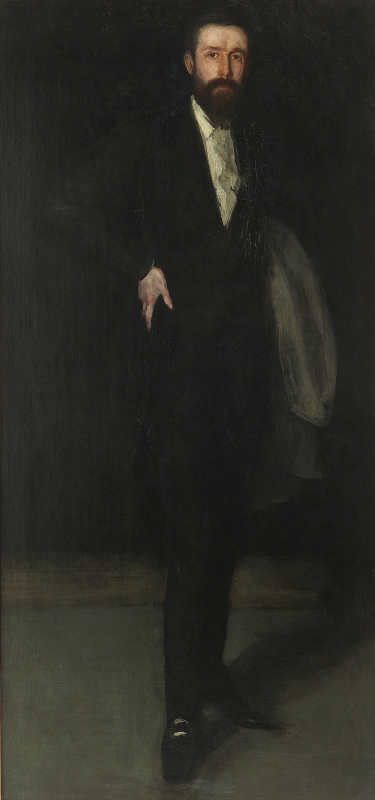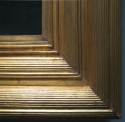Composition
Both Curry and Merrill note that the pose and dress of Leyland seen in the Portrait Sketch of F. R. Leyland [YMSM 096], and developed in Arrangement in Black: Portrait of F. R. Leyland [YMSM 097], are comparable to those in a portrait by Diego Rodriguez de Silva y Velázquez (1599-1660) of Philip IV (1623, Museo Nacional del Prado), of which Whistler had photographs. 1 It is not, however, certain when the artist acquired these photographs. 2
There are two preliminary oil sketches related to the portrait of Leyland, Study in Grey for the Portrait of F. R. Leyland [YMSM 095] and Portrait Sketch of F. R. Leyland [YMSM 096], reproduced above. They suggest a paler background was envisaged. The first shows Leyland turned slightly to his right, but looking at the viewer, with one hand at his throat, the other leaning on a cane. The second sketch is much closer to the final pose.
Technique
According to the Pennells, both the painter Valentine Cameron Prinsep (1836-1904) and Whistler's pupil Walter Greaves (1846-1930) said that Whistler had trouble painting Leyland's legs and had a nude model to pose for them. 3 Pentimenti show that Leyland's right leg was originally further to the left. The legs have in fact been made to appear more slender. The foot was tried out in various positions. There are signs of alterations to his right arm as well.
According to Walter Greaves, Whistler kept rubbing the portrait down, and eventually got 'a well known Italian model named Fosco to pose nude for the figure.' He added:
'Whistler would first of all paint the figure in flesh-coloured distemper, then add on the dress suit, then go over it in oil colour, then rub it all out and begin all over again. After about a year and a half he finished it and then said to me, "Now then, Walter, don't you think it is a very beautiful picture?" and it did turn out a very fine work of art, but the painting of it was a caution.' 4
Greaves added that one day Whistler's mother wished to see Leyland's portrait:
'the figure was at the time painted in the nude (in distemper). However she so insisted on seeing it that I had no alternative but to turn the canvas round from the wall. Then she remarked, "Oh dear! oh dear! I thought the picture was finished a long while ago; when will my son finish it?".' 5
The painting does not really show the traces of the long and frequent sittings that preceded it. Much of it is evenly and fairly thinly painted, this accentuated by some rubbing down, on the face for instance. The face and hands are carefully modelled, the final brushstrokes and highlights clearly differentiated. The frills of the shirt front are painted very freely with separate brushstrokes in creamy-textured bright white paint. The final flashy pink brushlike on his hands is pulled down into a point, so that his fingers appear pointed. The area above his head appears quite thickly painted, the brushstrokes curving around his head and presumably intended to be darker than his head.
Conservation History
The Freer Gallery files record that the painting was repaired in 1923; cleaned in 1922, 1923, 1935, 1951; resurfaced in 1923, 1937, 1951, 1952-53; the varnish and retouching was removed, and it was partially cleaned and inpainted, before being revarnished by Ben Johnson in 1965.
Frame
- 1874: original frame, style and whereabouts unknown, possibly flat profiled decorated frame.
- After 1905: Portrait Whistler frame, made in America. 6
Since Arrangement in Black: Portrait of F. R. Leyland [YMSM 097] was exhibited in 1874 with Symphony in Flesh Colour and Pink: Portrait of Mrs Frances Leyland [YMSM 106], it may have had a similar flat profiled decorated frame.
It is now in a Grau-style portrait frame, which probably dates from when Freer purchased it in 1905: it may be American/Detroit made. 7
Notes:
1: Curry 1984 [more] , plate 15; Merrill 1998 [more] , pp. 127-28, Portrait of Philip IV King of Spain by Velázquez, Glasgow University Library, repr. p. 129.
2: Portrait of Rey Felipe IV (Philip IV King of Spain) by Velázquez, albumen print, Glasgow University Library Whistler PH3/4 and 6; the first of these was published by A. Giraudon, 15 rue Bonaparte, Paris, which suggests it dates from after 1877. University Collections website at http://collections.gla.ac.uk/#/details/ecatalogue/337943.
3: Pennell 1908 [more] , vol. 1, pp. 175-77.
4: Marchant, William, Walter and H. Greaves (Pupils of Whistler), Goupil Gallery, London, 1922, pp. 19-20.
5: Quoted in Marchant 1922, ibid.
6: Dr Sarah L. Parkerson Day, Report on frames, 2017; see also Parkerson 2007 [more] .
7: Ibid.
Last updated: 23rd April 2021 by Margaret










